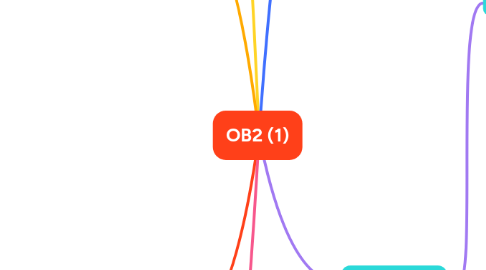
1. 6-Leadership
1.1. 2-Important Behavioral Studies
1.1.1. 1-Ohio State University
1.1.1.1. 1-Initiating structure
1.1.1.2. 2-Consideration
1.1.2. 2-University of Michigan
1.1.2.1. 1-Production-oriented
1.1.2.2. 2-Employee-oriented
2. 5-Organizational Culture
2.1. A common perception held by the organization’s members; a system of shared meaning
2.1.1. 1-Seven primary characteristics
2.1.1.1. 1-Innovation and risk taking
2.1.1.2. 2-Attention to detail
2.1.1.3. 3-Outcome orientation
2.1.1.4. 4-People orientation
2.1.1.5. 5-Team orientation
2.1.2. 2-Do Organizations Have Uniform Cultures?
2.1.2.1. 1-Dominant
2.1.2.2. 2-Subcultures
2.1.2.3. 3-Strong Culture
2.1.2.4. 3-Strong Culture
2.1.3. 3-What Do Cultures Do?
2.1.3.1. 1-Defines the boundary between one organization and others
2.1.3.2. 2-identity for its members
2.1.3.3. 3-commitment
2.1.3.4. 4-control mechanism
2.1.4. 4-How Culture Begins
2.1.4.1. 1-hire and keep
2.1.4.2. 2-socialize
2.1.4.3. 3-role model
2.1.5. 5-how to Keeping Culture Alive?
2.1.5.1. 1-Selection
2.1.5.2. 2-Top Management
2.1.5.3. 3-Socialization
2.1.6. 6-How Employees Learn Culture
2.1.6.1. 1-Stories
2.1.6.2. 2-Rituals
2.1.6.3. 3-Language
3. 4-Work Stress
3.1. Stress
3.1.1. the harmful physical and emotional responses that occur when the requirements of the job do not match the capabilities, resources, or needs of the worker.
3.1.1.1. 1-Types of Stress
3.1.1.1.1. 1-Challenge Stressors
3.1.1.1.2. 2-Hindrance Stressors
3.1.1.2. 3-Consequences of Stress
3.1.1.2.1. 1-Physiological
3.1.1.2.2. 2-Psychological
3.1.1.2.3. 3-Behavioral
4. 3-Communication
4.1. The transference and understanding of meaning
4.1.1. 6-Three Common Formal Small-Group Networks
4.1.1.1. 1-Chain
4.1.1.2. 2-Wheel
4.1.1.3. 3-All Channel
4.1.2. 8-Reducing Rumors
4.1.2.1. 1-Announce timetables for making important decisions
4.1.2.2. 2-Explain decisions and behaviors that may appear inconsistent or secretive
4.1.2.3. 3-Emphasize the downside, as well as the upside, of current decisions and future plans
4.1.2.4. 4-Openly discuss worst-case possibilities
4.1.3. 9-Barriers to Effective Communication
4.1.3.1. 1-Filtering
4.1.3.2. 2-Selective Perception
4.1.3.3. 3-Information Overload
4.1.3.4. 4-Emotions
4.1.3.5. 5-Language
4.1.3.6. 6-Gender Differences
5. 1-Group
5.1. Interest Group
5.1.1. 1-Role
5.1.1.1. A set of expected behavior patterns attributed to someone occupying a given position in a social unit
5.1.1.1.1. 1-Role Perception
5.1.1.1.2. 2-Role Expectations
5.1.1.1.3. 3-Role Conflict
5.1.2. 2-Norms
5.1.2.1. Acceptable standards
5.1.2.1.1. Classes of Norms
5.1.3. 3-Status
5.1.3.1. rank
5.1.3.1.1. Status derived from one of three sources:
5.1.4. 4-Size
5.1.4.1. -Twelve or more members is a “large” group - Seven or fewer is a “small” group
5.1.4.1.1. Best use of a group:
5.1.4.1.2. Social Loafing
5.1.4.1.3. Prevent social loafing by
5.1.5. 5-Cohesiveness
5.1.5.1. Degree to which group members are attracted to each other and are motivated to stay in the group
5.1.5.1.1. To increase cohesiveness:
6. 2-Work Teams
6.1. 2-Comparing Work Groups and Work Teams
6.1.1. 1-work groups
6.1.1.1. 1-share information (goal)
6.1.1.2. 2-neutral sometimes negative (synergy)
6.1.1.3. 3-individual (accountability)
6.1.1.4. 4-Random and varied (skills)
6.1.2. 2-work teams
6.1.2.1. 1-collective performance (goal)
6.1.2.2. 2-Positive (synergy)
6.1.2.3. 3-individual and mutual (accountability)
6.1.2.4. 4-complementary (skills)
6.2. 4-Key Components of Effective Teams
6.2.1. 1-Context
6.2.1.1. 1-Adequate Resources
6.2.1.2. 2-Effective Leadership
6.2.1.3. 3-Climate of Trust
6.2.1.4. 4-Performance evaluation and Reward Systems that Reflect Team Contributions
6.2.2. 2-Composition
6.2.2.1. 1-Abilities of Members
6.2.2.2. 2-Personality of Members
6.2.2.3. 3-Allocating Roles
6.2.2.4. 4-Size of Team
6.2.2.5. 5-Member’s Preference for Teamwork
6.2.3. 3-Work Design
6.2.3.1. 1-Freedom and Autonomy
6.2.3.2. 2-Skill Variety
6.2.3.3. 3-Task Significance
6.2.4. 4-Process Variables
6.2.4.1. 1-Commitment to a Common Purpose
6.2.4.2. 2-Establishment of Specific Team Goals
6.2.4.3. 3-Mental Map
6.2.4.4. 4-A Managed Level of Conflict
6.2.4.5. 5-Minimized Social Loafing
